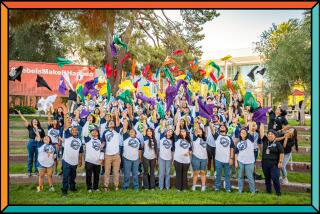High School Students Deal With Real-Life Issues at Conference : Education: Leaders from 7 Southland campuses discuss topics such as race relations, conflict resolution and apathy among their peers.
- Share via
Crenshaw High junior class president Dominique Ulloa was burned out on student leadership conferences.
But the one held at Crenshaw High last week that brought together student leaders from seven public and private campuses was decidedly different.
For one thing, it was organized by Ulloa and fellow leadership student Kristi Hernandez. And instead of discussing fund-raising tactics or designing posters--usual fare at such conferences, said Ulloa--students tackled such thorny issues as race relations, conflict resolution and how to structure life after high school.
Not the sort of issues to be resolved in one afternoon, but participants agreed that as elected leaders, it was their duty to examine the real-life problems and concerns of their peers.
“I wanted to talk about things that really go on on campus,” said Ulloa in her opening address in Crenshaw’s library. “We need to look at social issues, things that are really relevant to what’s going on today.”
About 40 students and adult advisers attended the daylong conference--Crenshaw’s first--which attracted participants from high schools from Compton to the San Fernando Valley: St. Mary’s, Verbum Dei, Dorsey, Hamilton, Taft, Chatsworth and Westchester.
*
Almost immediately, the predominantly black and Latino student leaders began detailing issues that made their jobs at their respective schools difficult: apathy, racial tensions, mistrust and lack of adult participation and support.
“People just don’t care,” complained Phoebe Magruder, a Hamilton senior. “It’s impossible to make people get excited, no matter what kind of events you plan.”
Fellow Hamilton student Khalid Morris suggested that student government bodies focus more on government and empowerment than traditional social activities such as proms and dances.
“We are the only link most students have to the administration, to the adults and the decisions they make,” he said of the students gathered. “So we need to understand ourselves how things work.”
Students agreed that racial divisions were a major problem at their schools, one that sabotaged events such as a Cinco de Mayo celebrations, in which only Latinos would show up, and poorly attended Proposition 187 forums. People stereotype each other and keep careful distances from different ethnic or racial groups, they said.
*
The problem was particularly aggravated at Westside and San Fernando Valley schools, where black and Latino students commuting from central Los Angeles often find it hard to mix, students said.
Westchester High junior Teri Emerson was distressed over the result of a multicultural fair she and other leadership students planned. “We tried to involve white students, but they saw us and literally ran away,” she said.
In the afternoon, the group broke into workshops to further address the day’s agenda: conflict resolution, racial interaction at schools, life after high school and student relations with the administration.
At the racial interaction workshop, moderated by Joel Juntilla of Los Angeles Unified’s Office of School Integration, St. Mary’s student Karla Larin said that she has endured being labeled Mexican by non-Latinos, though she is of Salvadoran and Guatemalan heritage. “There’s no respect of other cultures,” she said. “How do you explain to someone that you’re not Mexican? I’m here to find out what I can do about that.”
Linda Wilcox, a teacher at Chatsworth High, was scribbling notes at several workshops. Wilcox helped create a newly instituted conflict resolution course at Chatsworth--the only such course in the Los Angeles school district--and came to the Crenshaw conference to gather ideas. Every Chatsworth student must take the course to graduate.
“This is a real eye-opener,” she said of the conference. “The problem I’m hearing is one of values. It’s not really a black thing, or a white thing or Latino thing.”
More to Read
Sign up for Essential California
The most important California stories and recommendations in your inbox every morning.
You may occasionally receive promotional content from the Los Angeles Times.













